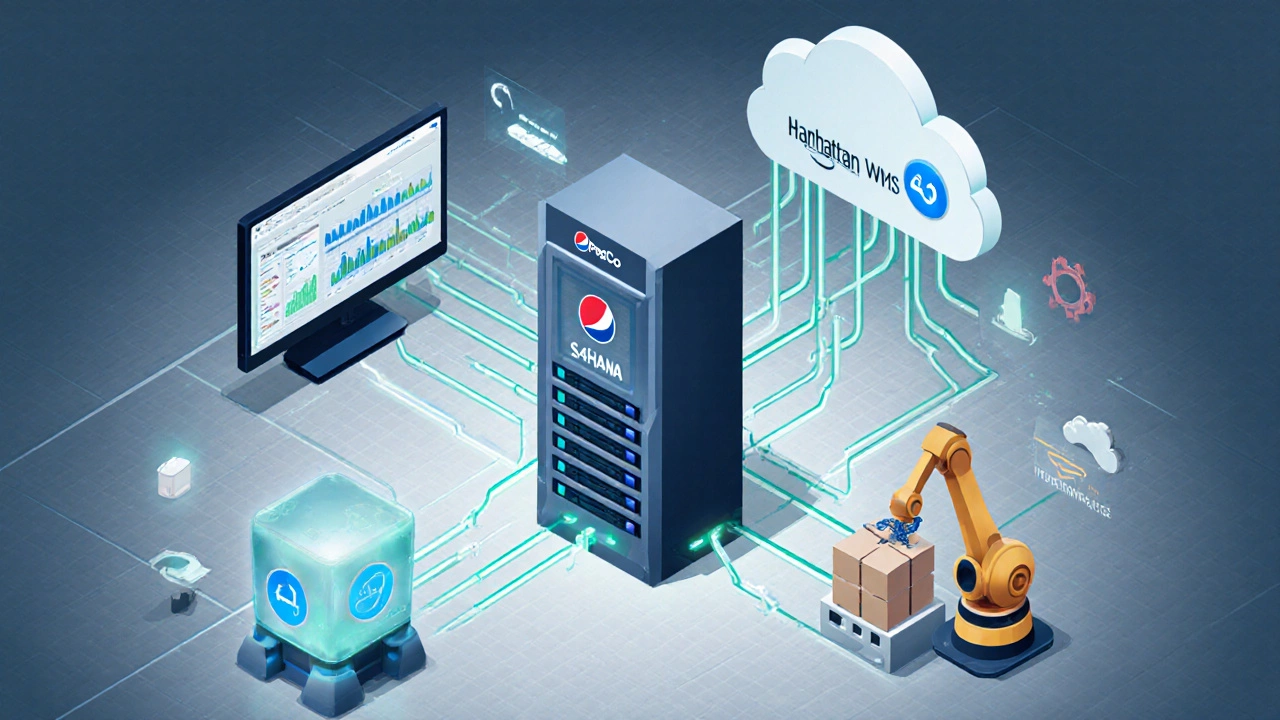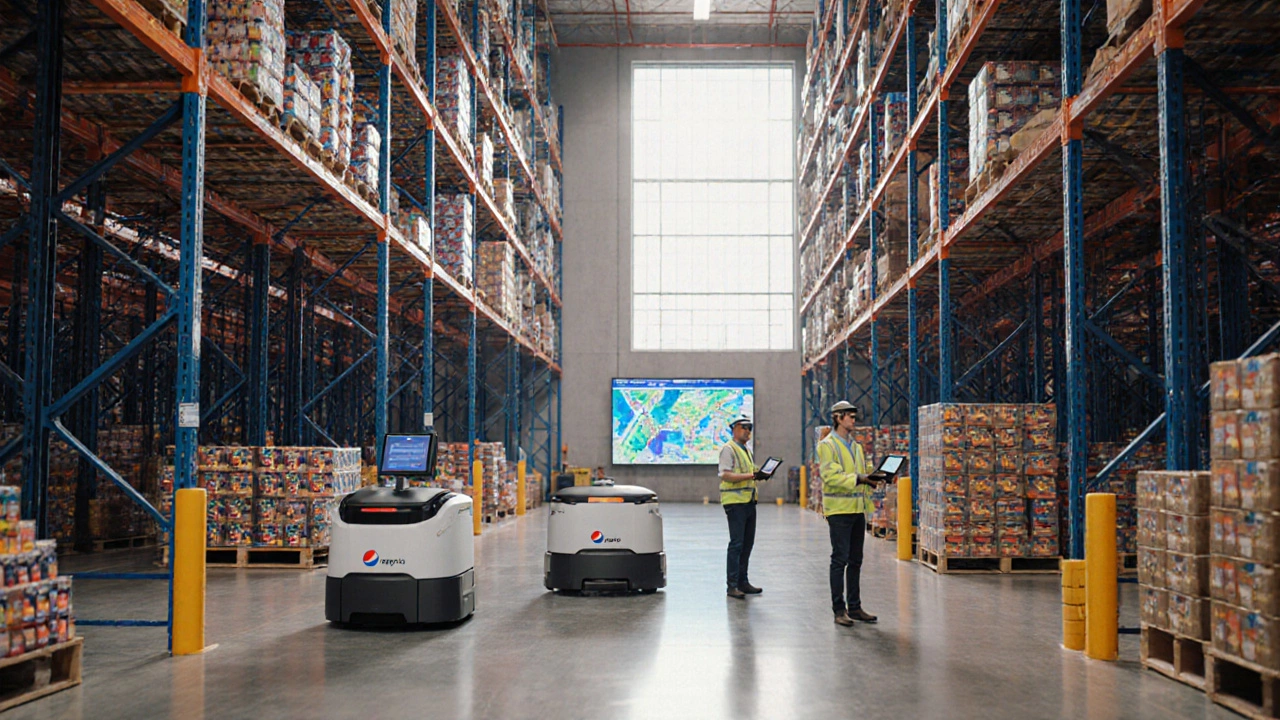PepsiCo is a global food and beverage powerhouse that ships billions of cases every year. To keep that massive flow moving, the company relies on a sophisticated Warehouse Management System (WMS) software that coordinates receiving, storage, picking and shipping inside distribution centers. If you’ve ever wondered exactly which WMS powers PepsiCo’s operations, you’re in the right place - we’ll break down the provider, why it fits PepsiCo’s scale, and what features matter most for a giant of this size.
Key Takeaways
- PepsiCo runs a customized version of Manhattan Associates’ WMS across most of its global distribution network.
- The platform handles real‑time inventory, AI‑driven slotting, and tight integration with SAP ERP.
- PepsiCo’s choice was driven by scalability, multi‑modal support, and a proven record in consumer packaged goods.
- Understanding PepsiCo’s setup helps any large enterprise evaluate WMS options for high‑volume, multi‑SKU environments.
- Future upgrades focus on AI forecasting, IoT sensor data, and advanced automation in newer DCs.
Why PepsiCo Needed a Robust WMS
PepsiCo moves roughly 400million cases of beverages and snacks each month. That translates to:
- Thousands of inbound pallets daily from bottlers and manufacturers.
- Complex cross‑docking flows to keep products fresh.
- Seasonal spikes that can double order volume during holidays.
- Regulatory and label‑compliance checks for different regions.
Legacy legacy systems couldn’t keep up. PepsiCo needed a solution that:
- Scales to millions of transactions per day.
- Provides real‑time visibility across more than 100 distribution centers worldwide.
- Integrates tightly with SAP ECC / S/4HANA for finance and procurement.
- Supports advanced automation like robotics pick‑to‑light and automated guided vehicles (AGVs).
These requirements narrowed the field to a handful of enterprise‑grade WMS providers.
The Provider PepsiCo Chose: Manhattan Associates
After a multi‑year RFP, PepsiCo selected Manhattan Associates as its primary WMS vendor. The decision hinged on three core strengths:
- Scalability: Manhattan’s platform handles over 10million transactions per hour, proven in other CPG giants.
- AI‑Powered Slotting: Their Dynamic Slotting engine continuously re‑optimizes storage locations based on demand forecasts, reducing travel distance by up to 15%.
- Seamless SAP Integration: Pre‑built adapters let inventory, order, and financial data flow bidirectionally without custom middleware.
PepsiCo rolled out Manhattan WMS in three phases - pilot in North America, expansion to Europe, and finally a global rollout covering Asia‑Pacific and Latin America.

Key Features PepsiCo Leverages
Here are the Manhattan modules PepsiCo uses most heavily:
| Feature | What It Does | Benefit for PepsiCo |
|---|---|---|
| Real‑Time Inventory Visibility | Tracks each case, pallet, and case‑mix in real time. | Eliminates stock‑outs and enables accurate order promise dates. |
| Dynamic Slotting & AI Forecasting | d>Uses machine learning to place fast‑moving SKUs in optimal locations.Reduces picker travel by 12‑15% and improves labor productivity. | |
| Advanced Labor Management | Plans labor shifts based on real‑time workload. | Aligns labor cost with demand spikes, cutting overtime. |
| Cross‑Dock & Flow‑Through | Supports direct transfer from receiving to outbound without storage. | Speeds up delivery of perishable snacks during promotions. |
| IoT & Sensor Integration | Collects temperature, humidity, and equipment health data. | Ensures product integrity for temperature‑sensitive drinks. |
How PepsiCo Integrates the WMS With Other Systems
Integration is the glue that makes the WMS useful. PepsiCo’s architecture looks like this:
- SAP S/4HANA: Core ERP handling finance, procurement, and master data.
- Manhattan WMS: Receives order releases from SAP, sends back inventory and shipment confirmations.
- Transportation Management System (TMS): Often a Blue Yonder TMS that plans truck loads based on WMS pick lists.
- Data Lake / Analytics: A Snowflake warehouse aggregates WMS event streams for dashboards.
- Automation Layer: Robots from Locus Robotics and conveyor control systems talk to Manhattan via OPC UA.
All communication happens over standard APIs (REST/JSON) and middleware such as MuleSoft that handles error handling and message transformation.
Alternatives PepsiCo Considered
Before committing, PepsiCo evaluated several other enterprise WMS platforms. Below is a quick snapshot of why each fell short of Manhattan’s sweet spot.
| Provider | Strength | Weakness for PepsiCo |
|---|---|---|
| Blue Yonder (formerly JDA) | Strong demand forecasting. | Less mature in large‑scale warehouse automation. |
| SAP Extended Warehouse Management | Native SAP integration. | Higher total cost of ownership and complex customizations. |
| Oracle Warehouse Management | Robust cloud offering. | Limited AI slotting capabilities at the time of evaluation. |
| Infor WMS | Good UI for mid‑size operations. | Scalability concerns for PepsiCo’s global volume. |
| HighJump (now Körber) | Flexible licensing. | Longer implementation timelines. |

What PepsiCo Is Planning Next
Even a leading WMS needs upgrades. PepsiCo’s roadmap includes:
- AI‑Driven Demand Sensing: Feeding POS data directly into Manhattan’s forecasting engine.
- IoT Expansion: Adding RFID tags and Bluetooth beacons for finer‑grained location tracking.
- Automation Scale‑up: Deploying more autonomous mobile robots (AMRs) in newer DCs.
- Cloud‑First Strategy: Moving some WMS micro‑services to AWS for elasticity.
These moves show that a WMS is not a “set it and forget it” tool - it’s a living platform that must evolve with market dynamics.
How to Evaluate a WMS for a Large Enterprise
If you’re a logistics leader looking to mirror PepsiCo’s success, consider these criteria:
- Scalability: Can the system handle millions of transactions per hour?
- Integration Suite: Look for pre‑built adapters to ERP, TMS, and automation gear.
- AI & Optimization: Real‑time slotting, labor planning, and demand forecasting are must‑haves.
- Global Support: Multi‑currency, multi‑language, and regional compliance modules.
- Total Cost of Ownership: Include licensing, implementation, training, and future upgrade fees.
Run a pilot in one region, measure KPIs (order lead time, picker travel, inventory accuracy), and then decide on a phased rollout.
Frequently Asked Questions
Which specific Manhattan WMS product does PepsiCo use?
PepsiCo runs the Manhattan Active Warehouse Management solution, customized with AI‑driven slotting and deep SAP integration.
How does the WMS talk to PepsiCo’s ERP system?
Manhattan provides a certified SAP connector that pushes order releases to the ERP and pulls inventory balances back in real time via SOAP/REST APIs.
What ROI did PepsiCo see after implementing Manhattan WMS?
Across its first three years, PepsiCo reported a 10% reduction in labor costs, a 12% boost in order‑to‑ship speed, and a 0.8% improvement in inventory accuracy.
Can smaller companies benefit from the same WMS?
Manhattan offers modular licensing, so midsize firms can start with core warehouse functions and add AI modules as they grow.
What are the biggest challenges when rolling out a new WMS?
Data migration, employee change‑management, and aligning custom business rules with out‑of‑the‑box functionality are the usual hurdles.





